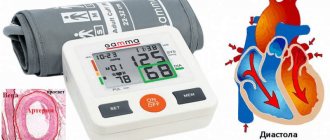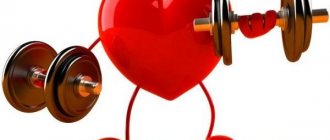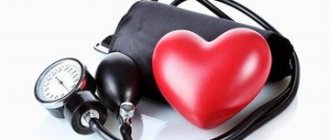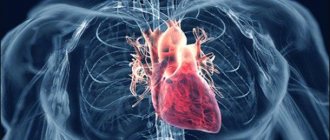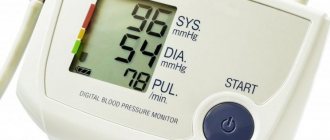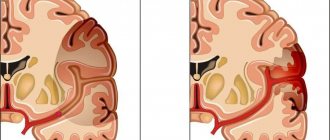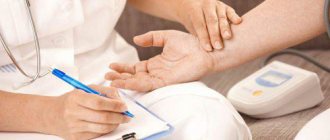Causes of hypotension after exercise
Changes in blood pressure levels after active exercise can occur for reasons such as:
- Vegetovascular dystonia. This phenomenon does not pose a particular danger: in this case, there may be a drop in blood pressure after physical activity, which does not threaten the patient’s life. With VSD, after exercise, the lumen of the vessels returns to its previous state slowly, as a result of which a temporary decrease in indicators occurs.
- Mitral valve prolapse. Most often, this pathology affects tall young men with a thin physique. A decrease in pressure can occur even with careless movement, moving the body from a sitting to a horizontal position.
- Low level of physical fitness or fatigue. Each person’s body is able to tolerate a certain level of stress, so this reason most often explains the drop in blood pressure after exercise.
- Weakness of the sinus node, various types of heart block (bradyarrhythmias).
- Angina pectoris.
Read more about all possible causes of low blood pressure -.
Whatever the reason for the decrease in blood pressure after physical activity, you should immediately consult a doctor.
Signs of the condition
The main signs of hypotension that occurs during and after sports activities include:
- feeling of weakness, faintness (especially if the lower part of the body is involved during training: buttocks, legs, shins);
- increased drowsiness;
- dizziness when performing exercises in which the head is lower than the level of the body.
Most often, such signs are observed in people with an insufficient level of physical fitness. Over time, after the body adapts, the above symptoms disappear.
How to control blood pressure during exercise?
Doing sports has a beneficial effect on a person’s health and general condition. When performing certain exercises, it is necessary to observe the measure to prevent the opposite effect. To do this, you should monitor your blood pressure.
People who play sports professionally measure their blood pressure 20 minutes before exercise and 10 minutes after it.
It is also necessary to monitor your blood pressure during exercise. For these purposes, you can use a fitness bracelet. It will help not only track blood pressure levels, but also measure other indicators: heart rate, number of steps taken and calories burned.
Acceptable workouts for hypotension
If a person suffers from low blood pressure after exercise, this does not mean that he should not lead an active lifestyle at all. With this problem, you can engage in sports such as:
- Swimming and water aerobics. A positive feature of these activities is the involvement of all muscle groups. During exercise, water puts pressure on the human body, thereby increasing the elasticity and filling of blood vessels.
- Jogging. It is better to start this exercise with a calm walk, gradually increasing the pace, while the running speed should not exceed 7-8 km/h. You should also gradually increase your jogging time. It is very useful to combine jogging with brisk walking.
- Dancing. There are many types of dance, but not all are suitable for people with low blood pressure. It is necessary to give preference to dances that are characterized by a calm pace, without sudden movements. Oriental or ballroom dancing is perfect.
- Yoga. If you choose this type of physical activity, you should consult with a specialist so that he can develop an individual set of exercises, taking into account the characteristics of the body.
- Cycling. During the ride, the leg muscles are actively involved, causing the blood to rise upward. This ensures its free circulation and, accordingly, relieves stagnation.
People with hypotension engaged in spores are advised to carry a bottle of sweet water with them. You need to drink it little by little, in between. It is best to exercise in the morning or evening.
Principles of constructing the training process in people with hypotension
If a person with low blood pressure goes to the gym, what is the best way for him to create a training program?
Important! It is advisable not to train at a fast pace.
It is better to go to the gym a couple of hours after waking up or in the evening. It’s good to take some kind of sweetened drink, tea, juice, compote to training. You can drink a little after each approach, or before classes it is recommended to eat something sweet (marmalade, a piece of chocolate, etc.).
Before starting your workout, you need to do a ten-minute warm-up. It should take place at a calm pace and last 1-15 minutes.
Drink after approaches
Exercises such as crunches, hyperextension, incline bench press, and deadlift can dramatically increase blood pressure, causing dizziness and even fainting. If you feel worse while doing them, then you should drink something sweet and lie on the floor, raising your legs a little higher than your head.
All lower body workouts are best done before the end of your workout.
Special set of exercises
It is also useful for people with low blood pressure to perform the following exercises:
- Ordinary walking. At first you need to limit yourself to 5-10 minutes, then gradually increase the time (but no more than half an hour).
- Pushups. During the exercise, you need to keep your back straight and place your arms slightly wider than your shoulders.
- Abs training. Take the starting position (lying on your back, feet on the floor, hands behind your head). First, raise your head, neck and shoulders, and then your upper body. The exercise must be performed slowly, at an average pace.
- Squats. It is important not to bend your back while doing squats.
- Lunges forward. The technique is as follows: take a step forward, with your back straight, after which the knee of the front leg bends approximately 90 degrees. Then you need to return to the starting position. The same exercise is performed on the other leg.
- Bike. You need to lie on your back, raise your legs and spin imaginary pedals.
- Scissors. For arms, this exercise should be performed in a standing position, for legs - lying on your back.
- Holding your legs. You need to lie on your back, arms and legs should be in line. The head comes off the floor, and the feet rise above its level by 45 degrees. Hold this position for no more than 5 seconds, then return to the starting position. It is recommended to do 5-7 repetitions.
Regular repetition of the above exercises will help reduce the symptoms of low blood pressure. After two weeks of exercise therapy, blood pressure levels will return to normal, and the activity of the heart muscle and lungs will improve.
It is important to breathe correctly during exercise. Experts recommend breathing through your nose. It is necessary to compare motor acts with the rhythm of breathing.
Breathing exercises are an integral part of any training process. Experts recommend doing them 3 times a day. They need to be done before and after the main workout. When performing breathing exercises, it is important to control not only the intensity of inhalation and exhalation, but also the frequency of the rhythm. Regular breathing exercises will activate the respiratory tract system and fill the body's cells with oxygen.
Is it possible to exercise with low blood pressure? Exercises for hypertension
Problems with blood pressure mean that you need to adhere to a certain lifestyle and limit yourself in certain things. It is known that when playing sports, many indicators change, including blood pressure. This is not a reason to refuse physical activity - you just need to select it wisely and monitor your health.
The effect of physical activity on blood pressure
During physical activity, blood circulation accelerates sharply, therefore the flow of blood in the vascular system increases. As a result, blood pressure rises. Typically, the higher the load, the more the blood flow accelerates. In a healthy person, this process is important for the normal functioning of the body, if the permissible limits are not exceeded.
Blood pressure may also decrease during exercise, but this condition is considered abnormal and indicates serious health problems.
Recommended sports for hypotension, features of physical activity
There is no need to avoid sports if you have low blood pressure. The correctly selected type and intensity of physical activity will not only not cause harm, but will also strengthen the cardiovascular system.
If you have low blood pressure, you can engage in the following sports:
- Jogging. It is better to start with walking, and then move on to running at a calm pace, not exceeding a speed of 7-8 km/h. Running time is increased gradually and slowly. It is effective to alternate jogging with fast walking.
- Swimming and water aerobics. This sport is good because it involves all muscle groups. While swimming, water presses on the human body. This is important for increasing the elasticity and filling of blood vessels.
- Cycling. When riding a bicycle, the leg muscles actively work, causing the blood to rise to the top. This ensures its circulation and relieves stagnation.
- Yoga. It is worth doing it individually, so that the complex is developed taking into account the characteristics of the body. For hypotensive people, evening yoga classes are especially effective.
- Dancing. There are many varieties of this sport, but with hypotension the choice is limited. You should choose dances in a calm rhythm, without sudden movements. Ballroom and oriental dancing are good.
- Pilates.
- Callanetics.
- Exercise equipment. You need to exercise in moderation, and coordinate the complexes with the trainer. Exercise bikes and treadmills are allowed (slow pace).
- Table tennis.
Hypotonic people should remember that when playing any sport, you need to have sweet water with you. You need to drink it little by little during breaks. It is better to do sports in the morning or evening.
For low blood pressure, physical therapy is also indicated. It can be done at any age.
A set of exercises for hypotensive patients
With low blood pressure, physical activity should be moderate. You should start with simple exercises. The load should be increased gradually, focusing on the state of your health.
It is recommended to perform the following set of exercises:
- Walking. At first, you can limit yourself to just this or start studying with it. For the first time, a 5-minute walk is enough, then the time should be gradually increased to half an hour.
- Tilts. This exercise should be done carefully, avoiding sudden movements. You need to lean forward and to the sides. For dizziness, this exercise is contraindicated.
- Push ups. You should start with simplified exercises, push-ups from the wall or on your knees.
- Swing your legs while lying down. You need to raise your straight legs one by one, holding them in this position a little.
- Squats. First, you should use a low chair for exercise, then you can do without it, but keep the body position the same.
- Lunges forward. The back should be straight, and the front knee should be bent at a right angle. In the future, this exercise can be performed with dumbbells.
- Bike. To do this exercise, you need to lie on your back and spin imaginary pedals.
- Scissors. For the legs, this exercise is done in a lying position, for the arms - while standing.
When performing exercises, you should remember about proper breathing. It is useful to practice breathing exercises. During training, you need to breathe through your nose. The rhythm of breathing must be synchronized with the movements - all jerks are made while inhaling.
For hypotensive people, exercises that need to be done lying on the floor are good. This position should also be taken if you feel unwell or dizzy during training. In this case, you need to drink sweet water or tea.
If you have hypotension, the order of exercises must be arranged correctly. You should always start with a warm-up. Leg exercises are done at the end of the workout. Transitions should be made smoothly, warming up before each complex. For the best effect and good health, you need to exercise every day.
Hypotonic patients need to constantly monitor their blood pressure. It is imperative to take measurements before and after training to calculate the changes that have occurred. Based on this result, it is necessary to adjust the duration and intensity of sports activities.
Professionals know that it is optimal to take measurements 20 minutes before training and 10 minutes after it.
It is recommended to monitor indicators during training. It is convenient to use special fitness bracelets for this. They measure not only blood pressure, but also other indicators, such as heart rate and blood oxygen levels.
Prohibited physical activities and sports
If you have low blood pressure, you should forget about most professional sports, as they mean high loads and constant training. The following sports should be excluded:
- Weightlifting;
- triathlon;
- body-building;
- powerlifting;
- some types of dancing, such as breakdancing;
- sprint, marathon running;
- sports sauna;
- motorsports;
- American football;
- struggle;
- hockey;
- figure skating;
- acrobatics.
Any sport can be played at different intensities. If you have low blood pressure or other health problems, you should consult your doctor. He will take into account the individual characteristics of the patient, determine the possibility of practicing a specific sport, and give recommendations on the intensity of the load.
In some cases, physical activity is contraindicated. This mainly applies to people whose pressure surges are pronounced and can occur without the influence of any factors. Physical activity is dangerous for heart disease, which provokes pressure changes.
Hypotension is not a reason to give up sports. It is important to choose the right direction and intensity of loads. During training, it is necessary to monitor blood pressure and other important indicators. You should choose a suitable sport taking into account the recommendations of your doctor. It is safer and more effective to exercise under the supervision of a trainer.
Source: https://serdce.biz/zabolevaniya/ard/gipotoniya/mozhno-li-zanimatsya-sportom-pri-nizkom-davlenii.html
Recommendations for performing exercises
During training, you must adhere to the following rules:
- Regularity of classes. You need to do the exercises every day, remembering to alternate them and add new ones. It is also recommended to change the nature of the exercises and the number of repetitions.
- Duration of training (at least 3 months). A set of exercises for people with low blood pressure was designed in such a way that the effect was visible within a week after the start of exercise. But this does not mean that after a week you should stop training. Regular training over a long period will help not only significantly improve your condition, but also consolidate the results.
- Gradual increase in loads. If a person with hypotension decides to engage in physical exercise, then in the initial stages he should under no circumstances put too much strain on himself. This is due to the fact that the patient’s body must adapt to new conditions. In the case of a “sharp start,” certain problems with well-being may arise during the training process: headache, poor health, severe weakness. If they occur, it is necessary to stop physical activity, as this can provoke loss of consciousness.
- When training, it is very important to monitor your blood pressure; if they decrease, it is necessary to reduce the load level.
Are there any contraindications to playing sports with low blood pressure?
If you have low blood pressure, activities that can further lower your blood pressure are contraindicated. You should not perform exercises that require sudden changes in body position (for example, squats, crunches, bending, etc.), as this has a bad effect on blood pressure. For hypotension, it is advisable to increase the pace of exercise evenly and gradually.
After several months of light exercise, blood pressure may gradually return to normal. Physical activity should be regular, exercises and gymnastics should be enjoyable. It is recommended to consult your doctor before starting training.
Sports that you should not do if you have low blood pressure
Professional sports, as a rule, involve increased stress on the body, which should not be allowed for people with low blood pressure. Therefore, if you have hypotension, it is strictly forbidden to engage in sports such as:
- Weightlifting;
- body-building;
- motorsports;
- powerlifting;
- figure skating;
- hockey;
- acrobatics;
- marathon, sprint running;
- struggle;
- martial arts;
- some types of dances, for example breakdancing.
Before you start exercising, you should consult a doctor who will help you determine which specific sport is indicated in a particular case. The specialist will also give recommendations regarding the intensity of physical activity.
Hypotension after physical activity is not a reason to stop playing sports. With this problem, it is important to choose the right type of sports activity and the degree of intensity of the load. During the training process, it is necessary to monitor blood pressure and other indicators. It is best to exercise under the supervision of an experienced specialist.
It is not at all clear why blood pressure drops during physical activity, because the greater the load, the higher the vascular tone should be. And in general, how can such a paradox affect the body? Can people with this type of reaction easily improve their health by “pulling iron” or, on the contrary, will excessive stress lead them to the grave? There are a lot of questions and it’s time to start giving at least some answers.
Extended training and recovery
After grueling physical activity, any body needs time to recover. The period of restoration of prolonged high blood pressure to normal is a process that occurs as a reaction to overwork and immediate replenishment of lost energy reserves. To do this, you need to give your body a break.
What pressure should be during physical activity depends on gender and age:
- men 18-55 years old - 121-129/79-84 mmHg. Art.;
- women 18-55 years old - 111-121/78-86 mmHg. Art.;
- the mark on the tonometer is 141/90 mmHg. Art. is considered borderline because it indicates the development of hypertension.
During exercise in the gym, blood pressure can increase by about 19 mmHg. Art.
In the presence of arterial hypertension, the indicators may be as follows: 141-158/91-98 mm Hg. Art. With these figures, you can play sports only with the permission of your doctor.
It is very important to give the body a break from exhausting physical activity. The greater the intensity during training, the longer you should rest after it. Some experts recommend keeping a diary, which includes your exercise and rest schedule, as well as your blood pressure levels before and after physical activity.
Rest time is approximately 24 to 48 hours, depending on the difficulty of the workout.
The acceptable heart rate is about 76 beats per minute two hours after physical activity.
To reduce it, you need to slowly inhale and exhale in a position with your hands resting on your knees.
Using this method, you can reduce the pressure level by about 20 beats per minute. There is another option, for which to be effective, you should straighten up, put your hands behind your head and start breathing calmly.
It will help you recover as quickly as possible after cardio or strength training. But, nevertheless, this method is not as effective as the previous one. Although it will also allow you to catch your breath as quickly as possible.
Rest is considered the main factor for full recovery after a grueling workout. For most athletes, about two days without going to the gym is enough.
How to determine response to physical activity?
To determine indicators of physical development and the body’s response to increased load, functional tests have been used in sports medicine since the beginning of the last century.
Now they are widespread, even schoolchildren must complete at least one such elementary test in order to be admitted to physical education classes:
- The subject rests for five minutes, his blood pressure is measured;
- He does 20 squats in 30 seconds, the cuff is not removed;
- Immediately after the load is completed, the pressure is re-measured.
If it eventually decreases, this may indicate:
- About predisposition to hypotension;
- About the low level of training of the person being tested;
- About a recent infectious disease;
- About general fatigue of the body.
What should hypotensive people do?
You should adequately assess your physical capabilities; it is possible that the physical activity was excessive, and this led to a breakdown in autonomic regulation. To prevent this from happening again in the future:
| General Tips | Specialized recommendations |
| Visit a cardiologist and undergo a full examination; perhaps some kind of pathology is hidden behind external well-being. | Visit the nearest physical clinic and make an appointment with a physical therapy doctor, you will be prescribed massages and special therapeutic exercises. |
| Do physical exercise according to methodological recommendations, strictly limit the load. | Find a good swimming pool in your city and get a membership; swimming also strengthens your heart muscle. |
| Spend as much time as possible in nature; it’s worth going to the sea. | Do not self-medicate and do not take heart medications on your own. |
It may be worth getting rid of at least some of your bad habits. At a young age, the effect of alcohol and smoking on the body is not so noticeable, but over the years, compensatory mechanisms fail. Maybe this is the first call.
Why do different hands have different pressures?
From a scientific point of view, it is necessary to measure blood pressure:
- At least twice per dose;
- At intervals of at least 30 minutes;
- On both hands;
- Lying and sitting, in a state of complete emotional peace.
But doctors at the clinic are officially given 12 minutes per appointment. If a specialist did not meet this time and was unable to “send out” the patient, he is a bad doctor, from the point of view of his superiors.
This level of workload does not allow us to pay enough attention to everyone in the outpatient clinics.
But the situation in hospitals is no better; everyone is used to working according to the same schemes. Blood pressure is always measured on one limb, neglecting the other. But even a difference of 15 units may indicate pathology:
- In elderly people, this is considered one of the precursors of atherosclerosis;
- In boys and young girls, such indicators occur in the presence of congenital pathologies;
- Without exception, all age groups are at risk of developing a brachial artery aneurysm.
It is not always necessary to look for a disease where it may not exist:
- The measurements take place within a few minutes of each other, during which time the patient may simply become nervous. Here is a different result;
- Everyone has one working limb; there are not so many people in the world who can use both hands equally. Accordingly, the muscle layer on the limbs is developed differently, and the same applies to the blood supply;
- On one arm, the neurovascular bundle may be pinched. This is also important in terms of health, but the results of measuring blood pressure in such conditions do not provide objective data on the state of the cardiovascular system.
Why does blood pressure drop during exercise? Causes of hypotension during physical activity
Summary of the article:
It is not at all clear why blood pressure drops during physical activity, because the greater the load, the higher the vascular tone should be. And in general, how can such a paradox affect the body? Can people with this type of reaction easily improve their health by “pulling iron” or, on the contrary, will excessive stress lead them to the grave? There are a lot of questions and it’s time to start giving at least some answers.
How to determine response to physical activity?
To determine indicators of physical development and the body’s response to increased load, functional tests have been used in sports medicine since the beginning of the last century .
Now they are widespread, even schoolchildren must complete at least one such elementary test in order to be admitted to physical education classes:
- The subject rests for five minutes, his blood pressure is measured;
- He does 20 squats in 30 seconds, the cuff is not removed;
- Immediately after the load is completed, the pressure is re-measured.
If it eventually decreases , it may indicate:
- About predisposition to hypotension;
- About the low level of training of the person being tested;
- About a recent infectious disease;
- About general fatigue of the body.
What should hypotensive people do?
You should adequately assess your physical capabilities; it is possible that the physical activity was excessive, and this led to a breakdown in autonomic regulation. To prevent this from happening again in the future:
| General Tips | Specialized recommendations |
| Visit a cardiologist and undergo a full examination; perhaps some kind of pathology is hidden behind external well-being. | Visit the nearest physical clinic and make an appointment with a physical therapy doctor, you will be prescribed massages and special therapeutic exercises. |
| Do physical exercise according to methodological recommendations, strictly limit the load. | Find a good swimming pool in your city and get a membership; swimming also strengthens your heart muscle. |
| Spend as much time as possible in nature; it’s worth going to the sea. | Do not self-medicate and do not take heart medications on your own. |
It may be worth getting rid of at least some of your bad habits. At a young age, the effect of alcohol and smoking on the body is not so noticeable, but over the years, compensatory mechanisms fail . Maybe this is the first call.
Why do different hands have different pressures?
From a scientific point of view, it is necessary to measure blood pressure:
- At least twice per dose;
- At intervals of at least 30 minutes;
- On both hands;
- Lying and sitting, in a state of complete emotional peace.
But doctors at the clinic are officially given 12 minutes per appointment. If a specialist did not meet this time and was unable to “send out” the patient, he is a bad doctor, from the point of view of his superiors.
This level of workload does not allow us to pay enough attention to everyone in the outpatient clinics.
But the situation in hospitals is no better; everyone is used to working according to the same schemes. Blood pressure is always measured on one limb, neglecting the other. But even a difference of 15 units may indicate pathology:
- In elderly people, this is considered one of the precursors of atherosclerosis;
- In boys and young girls, such indicators occur in the presence of congenital pathologies;
- Without exception, all age groups are at risk of developing a brachial artery aneurysm.
It is not always necessary to look for a disease where it may not exist:
- The measurements take place within a few minutes of each other, during which time the patient may simply become nervous. Here is a different result;
- Everyone has one working limb; there are not so many people in the world who can use both hands equally. Accordingly, the muscle layer on the limbs is developed differently, and the same applies to the blood supply;
- On one arm, the neurovascular bundle may be pinched. This is also important in terms of health, but the results of measuring blood pressure in such conditions do not provide objective data on the state of the cardiovascular system.
How does the cardiovascular system work?
The question of what blood pressure is and why its values are so important should have been asked a little earlier. But better late than never.
To answer the question, you need to remember the basics of anatomy :
- The heart is a muscular organ that acts as a pump;
- Our “pump” pumps blood “through pipes” - a network of vessels that permeate all organs;
- The most important thing is the blood supply to the brain and lungs; after its cessation, biological death will occur in a matter of minutes;
- The vessels themselves are hollow tubes consisting of connective and muscle tissue. Passing through them, blood encounters resistance from the vascular wall;
- The higher the pressure, the more intensely the blood pumps, the faster the heart works, and the better the organs are supplied with blood;
- After the pressure drops to zero, we return to point 3.
Your own “engine” should not be subjected to excessive loads ; since ancient times there has been an opinion that the heart of each person is designed for a certain number of contractions.
The more nervous we are and the faster our heart rate, the less we will live. At least according to this theory.
Why does blood pressure drop after exercise?
A decrease in pressure after exercise or any other load is considered a perverted reaction, because from a physiological point of view, completely different processes should be taking place in the body at this moment.
This reduction may be on
- Disruption of control of autonomic innervation. Soon, a diagnosis of VSD may appear in the medical record;
- Low level of training or overwork. Each body can only withstand a certain level of stress;
- Mitral valve prolapse;
- Angina;
- Hypotension.
Whatever caused this change, it wouldn’t hurt to see a doctor and undergo a full or even in-depth examination. You should know your body perfectly.
How does the cardiovascular system work?
The question of what blood pressure is and why its values are so important should have been asked a little earlier. But better late than never.
To answer the question, you need to remember the basics of anatomy:
- The heart is a muscular organ that acts as a pump;
- Our “pump” pumps blood “through pipes” - a network of vessels that permeate all organs;
- The most important thing is the blood supply to the brain and lungs; after its cessation, biological death will occur in a matter of minutes;
- The vessels themselves are hollow tubes consisting of connective and muscle tissue. Passing through them, blood encounters resistance from the vascular wall;
- The higher the pressure, the more intensely the blood pumps, the faster the heart works, and the better the organs are supplied with blood;
- After the pressure drops to zero, we return to point 3.
Your own “engine” should not be subjected to excessive loads; since ancient times there has been an opinion that the heart of each person is designed for a certain number of contractions.
The more nervous we are and the faster our heart rate, the less we will live. At least according to this theory.
Why does blood pressure drop after exercise?
A decrease in pressure after exercise or any other load is considered a perverted reaction, because from a physiological point of view, completely different processes should be taking place in the body at this moment.
This reduction may be based on:
- Disruption of control of autonomic innervation. Soon, a diagnosis of VSD may appear in the medical record;
- Low level of training or overwork. Each body can only withstand a certain level of stress;
- Mitral valve prolapse;
- Angina;
- Hypotension.
Whatever caused this change, it wouldn’t hurt to see a doctor and undergo a full or even in-depth examination. You should know your body perfectly.
Video: how activity affects blood pressure
In this video, Elena Polyakova in the “School of Health” program will tell you how pressure depends on physical activity, how it changes during the day, what its sharp changes mean:
Today, a sporty lifestyle has returned to fashion. Trying to keep up with fashion trends, many of us constantly count how many calories we burned in the gym. At the same time, few people think about whether blood pressure rises during physical activity, how it affects our body, and whether there is a need to fear for their health. From our article you will learn why sports causes blood pressure to fall or rise.
Video on the topic
What is normal pressure during exercise? Answer in video:
So, what pressure should an athlete have? The norm characterizing pressure after exercise is 131/84 mm Hg. Art. Experts recommend consuming special foods to improve the body’s condition and replenish energy reserves after physical activity. It is advisable to use various fruits, vegetables, berries, nuts, seafood, oils, as well as some foods enriched with potassium.
There is no need to exercise if you have health problems, in particular problems with the functioning of the heart and blood vessels. This will only aggravate the situation and provoke the development of unwanted ailments. It is enough to first consult with your doctor to find out whether you can go to the gym or not. And if you have some serious diseases, the doctor will help you choose the most suitable sports that will not harm the body.
Signs of low blood pressure after exercise
Sports often lower blood pressure. If this phenomenon is observed in an adult or child who has just started training, this is considered normal. But if a drop in pressure is recorded in a person who has been training for a long time, this can be regarded as a symptom of CVS pathologies.
Blood pressure drops after physical activity: reasons
Blood pressure may decrease due to:
- VSD. The blood vessels fail to adapt to the body’s needs in time, so a person’s blood pressure may drop after exercise. This phenomenon is not life-threatening for the patient;
VSD
- Heat stroke. In this case, even light exercise can cause a drop in blood pressure. In parallel with this, the person turns pale, visual hallucinations develop, and the risk of loss of consciousness increases;
Heatstroke
- Mitral valve prolapse. Most often, prolapse occurs in tall, thin people. Due to valve dysfunction, their blood pressure may decrease even as a result of a sharp change in body position in space.
- Paradoxical vascular reaction. Occurs in people with early stages of hypertension. Individuals who have been involved in sports in the past are at risk. Performing even simple physical exercises by such people can provoke a decrease in blood pressure to standard or reduced levels. At the same time, in a calm state, they often have high blood pressure;
- Weakness of the sinus node or various types of heart block. The electrical impulses sent by the heart rate driver are reduced or stop flowing altogether. This phenomenon negatively affects blood circulation and can reduce blood pressure;
- Angina pectoris and heart attack. These reasons lead to a sharp drop in pressure and cause squeezing pain in the heart or behind the sternum. In such a situation, a person needs to urgently call emergency medical help.
Pressure adjustment
If a person notices that blood pressure changes become more frequent during training, he needs to urgently consult a doctor. Most likely, he will discover some kind of pathology. If deterioration in health is caused by hormonal imbalance, mild hypertension or VSD, the patient may be prescribed special exercises to help the body heal without the use of medications.
Due to physical activity, blood pressure begins to increase: what is the normal blood pressure?
If during the training process blood pressure levels begin to change upward, this is considered normal. Each age category has its own blood pressure standard, but the generally accepted indicator is 120/80 mmHg. Art. Due to stress, systolic pressure temporarily increases to 190-200 mmHg. Art., diastolic – up to 90/120 mm Hg. Art.
Important! If the upper and lower pressure increases even more, perhaps the person is hypertensive, but does not yet know it.
Why does physical activity cause blood pressure to rise?
When you exercise, blood flow increases to provide oxygen to your muscles. This affects the hypothalamus, adrenal glands and brain, adrenaline is released into the blood, pulse and heart rate increase, and blood pressure rises. Due to intense exercise, the rate of blood circulation can increase significantly, and the same thing happens with blood pressure. This phenomenon is explained by the intensification of the work of the cardiovascular system:
- thanks to the increased speed, blood reaches organs and systems faster;
- the body is enriched with oxygen;
- the walls of blood vessels and arteries contract and tighten in order to properly regulate blood flow;
- Hormone production and metabolism are enhanced.
Monitoring blood pressure during and after training
To avoid having to be treated for hypotension or hypertension, you need to learn to control your blood pressure:
- measure your blood pressure 20 minutes before exercise and 15 minutes after;
- wear the right type of clothing (the body must breathe);
- make sure that ventilation is working in the training room and the optimal temperature is maintained;
- try to provide the body with the right amount of water;
- If you decide to go to the gym, consult a specialist.
Why does blood pressure drop during sports?
Often, due to physical activity, blood pressure begins to fall rather than rise. This phenomenon is explained by vagotonia. In a person with vagotonia, during stressful situations there is not an increase, but a decrease in blood pressure to 20 mm Hg. Art. When a person begins to run intensely, exercise on exercise machines or dance, his blood pressure can rise by a maximum of 10 mmHg. Art. Vagotonia often causes blood pressure to drop sharply without obvious reasons. When blood pressure levels change, a person may complain of:
- pain in the heart area;
- shortness of breath;
- fatigue.
Due to general weakness, organs and systems begin to work incorrectly, so physical exercise only increases the negative impact of vagotonia on the body.
Important! Therapy for vagotonia involves long walks in the fresh air and light jogging in the morning.
Jogging
What to do if your blood pressure is low?
Low blood pressure is considered to be pressure below 100/60 mm Hg. Art.
The main symptoms of low blood pressure are drowsiness, weakness, and dizziness. To increase it, you can drink a cup of strong tea or coffee. If the described complaints persist for several days against the background of low blood pressure, that is, excluding other possible causes for the appearance of the above symptoms, such as changes in weather, colds, overwork, it is necessary to consider the issue of adjusting therapy.
You need to understand that the same symptoms can develop in patients whose blood pressure has normalized, for example to 120/80 mmHg. after long-standing figures of 170-180 mm Hg. In this case, you must understand that this condition is temporary and some time is needed for the cardiovascular system to adapt to new conditions. Unfortunately, many patients are afraid of such symptoms and believe that this pressure is low for them, as a result they stop taking medications, thereby dooming themselves to the development of complications of hypertension.
Our readers successfully use ReCardio to treat hypertension. Seeing how popular this product is, we decided to bring it to your attention. Read more here...
Systolic (“upper”) pressure below 60 mm Hg is considered dangerous. With such pressure, urine filtration in the kidneys stops and kidney failure may develop, not to mention a decrease in oxygen supply to the brain and heart; in such cases, an ambulance must be called.
In conclusion, it must be said that especially for young women who do not have sufficient physical activity, low blood pressure is very common. And in such cases, playing sports has a very beneficial effect on this situation. In addition, you can use preparations containing Ginseng, they tone up and can somewhat normalize blood pressure.
Why can blood pressure decrease during physical activity? Causes of low blood pressure during exercise
Many people are surprised by the fact that exercise lowers blood pressure. Why is this happening? How to check your tendency to hypotension?
How to determine the effect of physical activity on the body?
To determine physical development and the body's response to power load, sports medicine began to actively resort to the use of functional tests. Today these checks are even used in schools. Here is an example of one of them:
- The person rests for five minutes, after which blood pressure is measured;
- 20 squats are performed in half a minute, the cuff remains in the same place;
- Upon completion of the exercise, the person's blood pressure is measured again.
If a downward change in indicators is recorded, this can be regarded as a sign:
- tendency to hypotension;
- poor physical fitness of the subject;
- recent infectious disease;
- general fatigue.
What to do for hypotensive people: table with tips
To minimize the negative consequences of blood pressure changes and train correctly, you need to follow a few simple recommendations.
| General rules | Special rules |
|
|
To enhance the results of treatment, it is recommended to give up addictions. In youth, alcohol and nicotine intoxication are normally tolerated by the body, but over time, compensatory mechanisms may fail.
Stop smoking
Is it possible to play sports with low blood pressure?
Sports are very useful, but not for everyone and not always.
Thus, for some diseases and pathological conditions, increased physical activity is contraindicated. Is it possible to play sports with hypotension? And how to do this correctly without harm to health? There are two main types of hypotension: muscular and arterial. Each one is worth talking about in detail.
Muscular hypotonia is a decrease in muscle tone and strength. Most often it is diagnosed in children, especially in the first years of life, but it rarely occurs in adults. Often this condition is not an independent disease, but only a consequence of some illness.
Causes of muscle hypotonia include congenital malformations and diseases such as Down syndrome, spinal muscular atrophy, Rett syndrome, teratogenesis, cerebellar ataxia, sensory integration dysfunction, dyspraxia, and so on.
Also, some infectious diseases (encephalitis, polio, botulism, meningitis) and autoimmune diseases (myasthenia gravis, celiac disease) can lead to the development of muscle hypotension. In addition, among the causes are toxic lesions and poisoning with heavy metals and some poisons, neurological problems, traumatic brain injuries, metabolic disorders (rickets, hypervitaminosis).
The main symptom of muscle hypotension is muscle weakness and the inability to perform physical exercises (even simple ones), and sometimes even habitual actions. Speech disturbances, absent-mindedness, and constipation may also occur. Manifestations will depend on the severity and characteristics of the disease causing hypotension.
Treatment should be aimed, first of all, at eliminating the cause of the pathological condition, as well as strengthening muscle tissue. Massage and some other procedures are effective, for example, electromagnetic therapy, acupuncture, electrophoresis and others.
Special therapeutic gymnastic exercises are useful. In some cases, a special diet may be required. Sometimes medications are prescribed to increase muscle tone.
Arterial hypotension (it would be more correct to call it hypotension) is a decrease in blood pressure by 20% or more from the initial and normal level for a person.
Possible causes of hypotension: stomach ulcer, anemia, vegetative-vascular dystonia, diabetes mellitus, tumors of the brain and some other organs, shock, liver cirrhosis, brain or spinal cord injuries, osteochondrosis of the cervical spine, pancreatitis, hepatitis, decreased blood volume in the body (it may be associated with internal bleeding and large blood losses), neuroses, depression, stress, panic attacks, intracranial hypertension, heart failure, some vascular diseases, decreased function of the thyroid gland or adrenal glands, lack of certain substances, increased physical or mental stress, intake some medications, sudden changes in climatic conditions.
- drowsiness, weakness, lethargy in the morning and at the end of the working day, increased fatigue;
- mood swings, irritability, emotional instability, apathy;
- increased sensitivity to any changes in weather conditions;
- memory impairment, decreased concentration, absent-mindedness;
- thermoregulation disorders: increased sweating, cold extremities;
- pale skin;
- increased heart rate, shortness of breath, especially after increased physical exertion;
- nausea, tendency to rapid motion sickness while traveling in transport;
- dizziness, darkening of the eyes, lightheadedness and even fainting;
- headaches (usually dull, tightening or bursting, localized in the temporal or parietal zone).
Treatment of arterial hypotension should be aimed, first of all, at eliminating the causes of this condition.
To relieve symptoms, tonic drinks, for example, based on caffeine or ginkgo biloba, can be used. To increase blood pressure, herbal preparations containing extracts of ginseng, echinacea, lemongrass, immortelle, and so on are usually used.
Some procedures and hardware methods can be used, such as acupressure, darsonvalization, aeroionotherapy, reflexology, electromagnetic therapy and so on. Treatment with folk remedies is possible. Decoctions of eleutherococcus, hawthorn and other plants are used.
The right lifestyle plays an important role. Its main principles:
- Small and balanced meals.
- Moderate and regular physical activity.
- Increasing vascular tone with cold water douches and contrast showers.
- Normal sleep.
- Preventing stress and anxiety.
- Maintaining a daily routine, rational alternation of rest and activity.
- Rejection of bad habits.
With severe muscle hypotension, full-fledged exercise is not always possible, but moderate exercise will increase muscle tone and improve the condition. The doctor should select the exercises.
In any case, the exercises should not be too intense and complex, and the load should be increased gradually. And under no circumstances overexert yourself!
Basic rules for playing sports with arterial hypotension:
- Before starting your workout, you can eat or drink something sweet. This will increase blood sugar levels and thereby normalize blood pressure. You can also have small carbohydrate snacks after the most difficult exercises.
- It is best to plan classes for the evening or first half of the day (about two or three hours after waking up). During these periods, most hypotensive patients experience a surge of strength.
- Be sure to warm up, and at a calm pace. You can do simple exercises such as walking, swinging your arms or legs, or riding an exercise bike. The duration of the warm-up should be at least 10 minutes.
- The workout should take place at a calm pace; increasing it is unacceptable, as it can lead to fainting.
- Avoid exercises that involve sudden changes in body position (for example, twisting, bending and lifting, squats).
- If there are any warning signs, stop training. Drink something sweet and lie down on a bench or floor (you can raise your legs up). After five minutes, try to continue exercising. If symptoms persist, postpone training for another time.
And remember that hypotension is not an obstacle to playing sports! But you still need to follow some rules.
Source: https://folkmap.ru/krov/mozhno-li-zanimatsya-sportom-pri-davlenii-ponizhennom/
Bottom line
If you notice that after training your blood pressure does not return to normal for a long time, immediately seek qualified help. Perhaps you have chosen the wrong loads for yourself, and the next stage after changes in blood pressure will be the development of a serious illness.
Physical activity is often accompanied by a decrease in blood pressure. When this condition occurs in athletes or children whose bodies are adapting to new conditions of accelerated growth, it is completely normal. It’s another matter when habitual physical activity leads to a drop in blood pressure. Then it’s worth thinking about pathologies of the cardiovascular system.
What does low blood pressure mean after exercise?
- The most harmless disease in which low blood pressure after exercise does not threaten life is vegetative-vascular dystonia. In this case, the lumen of the vessels does not have time to adequately adapt to the body’s requirements and a drop in pressure may occur.
- If you overheat in the sun and get heatstroke, even minor work or stress on the body can lead to a decrease in blood pressure below 90 to 60. In this case, the person turns pale, spots appear in his eyes, dizziness, and he may lose consciousness.
- Mitral valve prolapse, which often affects tall and thin young men, can also cause a drop in blood pressure even when standing up suddenly.
- A paradoxical vascular reaction is typical for patients with the initial stages of hypertension, especially if they have been involved in sports for several years before. Physical activity in such people leads to a decrease in blood pressure to normal or low numbers, while at rest they may have high blood pressure.
- More serious conditions are weakness of the sinus node and various types of bradyarrhythmias (heart block). In this case, electrical impulses from the pacemaker either do not reach at all or are significantly reduced. As a result, blood flow suffers and blood pressure may drop. Weakness of the sinus node requires surgery to establish a pacemaker, and arrhythmias require conservative treatment.
- Very low blood pressure after exercise combined with a prolonged attack of squeezing or pressing pain in the heart or behind the sternum is a sign of severe angina or myocardial infarction. In this case, you should immediately put a nitroglycerin tablet under your tongue or spray it with nitro spray and immediately call an ambulance.
Prohibited physical activities and sports
If you have low blood pressure, you should forget about most professional sports, as they mean high loads and constant training. The following sports should be excluded:
- Weightlifting;
- triathlon;
- body-building;
- powerlifting;
- some types of dancing, such as breakdancing;
- sprint, marathon running;
- sports sauna;
- motorsports;
- American football;
- struggle;
- hockey;
- figure skating;
- acrobatics.
Any sport can be played at different intensities. If you have low blood pressure or other health problems, you should consult your doctor. He will take into account the individual characteristics of the patient, determine the possibility of practicing a specific sport, and give recommendations on the intensity of the load.
Hypotension is not a reason to give up sports. It is important to choose the right direction and intensity of loads. During training, it is necessary to monitor blood pressure and other important indicators. You should choose a suitable sport taking into account the recommendations of your doctor. It is safer and more effective to exercise under the supervision of a trainer.
Join the discussion Cancel
It is strange that the author of this article considers ballroom dancing to be dancing “in a calm rhythm, without sudden movements.” Apparently, he is not familiar with their sports direction with their intense loads and dynamics. One jive is worth it.
As I understand it, this means amateur activities, where, apart from waltzing to a slow melody and a few innocent steps, nothing more difficult happens. My mother went to such classes. At the school, they were held in the evening by girl teachers. They rented a gym and organized groups for ballroom dancing and belly dancing for women. These are far from professional classes with their loads. The article, on the contrary, says that you should forget about professional sports...
Hi all! I am hypotensive, and in the past I was involved in bodybuilding for about two years. Yes, the first training sessions were hard, sometimes I felt dizzy and my heart jumped out of my chest. But then, in general, I began to feel great, my body got used to this rhythm. While bending over, I didn’t feel dizzy like before the classes, I became more active. Afterwards there was a break from classes for 4 years! But all this time I felt much better. Now I’m back in the gym, doing CrossFit (the doctors would probably smoke nervously on the sidelines if they knew that a hypotensive person was doing such a difficult sport for the cardiovascular system). At the first training session I almost died, it was so bad. But on my second trip to the gym I felt much better, plus I adjusted my diet. Now the standard warm-up before the main exercises is 5 push-ups, 10 press sets and 15 squats, which are done without rest for 3 circles in a row, and are done lightly. And there are absolutely no problems with blood pressure. In the end, what I want to say! Don't listen to anyone, no doctors or doctors! Medicine is now geared not for the benefit of your health, but for the benefit of replenishing the coffers of pharmaceutical companies! You can do more than you think. And if anyone tells you that after 40 all your sports activities will come back to haunt you, just smile. After all, at the current standard of living, not everyone will live to be 60 years old. Is it bad that you can live every day feeling great and without wasting valuable days standing in line at the clinic? Sport - is life. Moderate, headstrong, but sporty! P.s.: and so, lastly. I once came to the hospital to ask the doctor for advice on how to properly monitor the condition of my heart after training, how to recover, and train it. He looked at me from under his forehead as if I were a fool and uttered a phrase that I will probably never forget. He said: are you hypotensive? Give it up. Dot.
Ilya, I only agree with one of your phrases: “Sport is life. Moderate, headstrong, but sporty!” Bodybuilding and crossfit are an excessive load on the human body, especially if he has any health problems. I ask people to think about why they leave sports early? The answer is simple... sport is wear and tear on the body. But moderate cardio exercise, swimming, etc. types of active physical activity are very necessary and right!
Man, you want to pump up your body to increase your self-esteem or improve your health. It looks like the first one)))
Don't self-medicate! Before using instructions and advice from websites, discuss them with your doctor!
How to adjust pressure
If a person suffers from strange surges in blood pressure: he has high blood pressure or low blood pressure after exercise, he should see a doctor and be seriously examined - all pathological situations should be under the supervision of a cardiologist. With vegetative-vascular dystonia, blood pressure fluctuations against the background of hormonal imbalances, with mild forms of hypertension, extrasystole, it is possible to take care of your health using not so much drugs, but the body’s hidden capabilities for self-regulation. Specialists from the M.S. Norbekov Center can help with this. Here, for example, health courses for hypertension and a “Healthy Endocrine System” course are held, which can help cope with the problem of unstable blood pressure.
